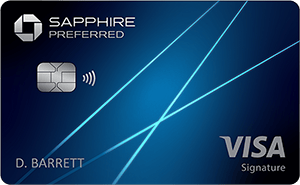7 Things to Know Before Getting the Chase Sapphire Preferred
Consider factors like your credit score, travel plans and the Chase 5/24 rule before applying.

Many or all of the products on this page are from partners who compensate us when you click to or take an action on their website, but this does not influence our evaluations or ratings. Our opinions are our own.
The Chase Sapphire Preferred® Card remains a standout choice for travel enthusiasts at every level. The card offers an impressive array of bonus rewards categories, a valuable welcome bonus and a modest annual fee — especially considering the value you can get.
But like any credit card, the Chase Sapphire Preferred® Card isn't the best fit for everyone. Here are seven things to consider as you weigh whether it's the best fit for you, your spending habits and your travel plans.
1. Your credit score
The Chase Sapphire Preferred® Card targets borrowers with strong credit profiles — you'll typically need good to excellent credit for approval chances.
We recommend that you consider waiting to apply until your FICO score reaches at least 690. If you're still building your credit history, focusing on that first makes sense. Check out these top beginner-friendly credit cards as potential stepping stones.
Get up to 100,000 bonus points with our favorite Chase cards
Check out our nerdy picks for the best Chase credit cards and find the right card for you.

2. Your Chase 5/24 count
Chase's unofficial 5/24 rule will likely block your application if you've been actively opening credit cards recently. This unwritten policy typically results in denials for applicants who have opened five or more credit cards (from any issuer) within the past two years.
The policy does have certain exceptions. For example, business credit cards usually fall outside this restriction since they're linked to commercial entities rather than personal credit profiles. But you'll still want to review your credit reports before applying to confirm where you stand.
» Learn more: The best Chase credit cards right now
3. The annual fee
While Chase Sapphire Preferred® Card's annual fee of $95 is modest compared to premium travel credit cards that can cost $500 or more, it's still an expense worth evaluating. Factor this cost into your overall credit card budget, particularly if you're already carrying annual fees on other cards in your wallet.
With any annual-fee card, it's important to evaluate the card's features to determine how easy it will be to recoup that yearly expense. With the Chase Sapphire Preferred® Card, consider the following:
- Earn up to $50 in statement credits each account anniversary year for hotel stays booked through Chase.
- Get a complimentary DashPass membership, valued at $120 per year, through Dec. 31, 2027, or a minimum of one year depending on the activation date. You must activate by Dec. 31, 2027, to be eligible.
- DashPass members get a $10 promo each month ($120 annually) to save on groceries, retail orders and more through Dec. 31, 2027.

The hotel credit can make up for just over half of the card's annual fee of $95, but you'll also need to consider the total cost of the stay, especially if you weren't already planning to spend that money.
In contrast, the DoorDash benefits can more than offset the $95 annual fee, but again, you have to spend money to earn the credits. If you're an on-demand diner, that might not be an issue. Otherwise, it can be easy to spend more than you save in credits.
4. Your eligibility for the welcome bonus
The Chase Sapphire Preferred® Card's welcome bonus offers outsized value for new cardholders: Earn 75,000 bonus points after you spend $5,000 on purchases in the first 3 months from account opening.
But being eligible for the card doesn't mean you qualify to earn the bonus. More specifically, you may not qualify for the bonus if you currently hold any personal Sapphire card (including the Chase Sapphire Preferred® Card or the Chase Sapphire Reserve® ), you've previously owned this specific card, or you've already received a welcome bonus for it in the past.
Chase also evaluates your broader credit card activity, including how many accounts you've opened and closed recently, along with other undisclosed factors.
You'll also want to gauge whether you can meet the minimum spending requirements with your regular everyday spending. Over three months, the $5,000 threshold translates to $1,667 per month.
How the cards compare
Annual fee
$95
$795
Sign-up bonus
Chase Sapphire Preferred® Card
Earn 75,000 bonus points after you spend $5,000 on purchases in the first 3 months from account opening.
Chase Sapphire Reserve®
Earn 125,000 bonus points after you spend $6,000 on purchases in the first 3 months from account opening.
Rewards
Chase Sapphire Preferred® Card
- 5 points per $1 spent on travel booked through Chase.
- 3 points per $1 spent on dining (including eligible delivery services and takeout).
- 3 points per $1 spent on select streaming services.
- 3 points per $1 spent on online grocery purchases (not including Target, Walmart and wholesale clubs).
- 2 points per $1 spent on travel not booked through Chase.
- 1 point per $1 spent on other purchases.
Chase Sapphire Reserve®
- 8 points per $1 spent on travel booked through Chase.
- 4 points per $1 spent on flights booked directly with airlines and stays booked directly with hotels.
- 3 points per $1 spent on dining.
- 1 point per $1 spent on other purchases.
Other benefits
Chase Sapphire Preferred® Card
- A $50 annual credit on hotel stays booked through Chase.
- Each account anniversary, cardmembers will earn bonus points equal to 10% of total purchases made the previous year.
- 1:1 transfer partners, including United, Southwest, JetBlue, Marriott and Hyatt.
Chase Sapphire Reserve®
- $300 annual credit, automatically applied to travel spending.
- Hundreds of dollars a year in travel, entertainment and lifestyle credits.
- 1:1 transfer partners (same as the Chase Sapphire Preferred® Card).
- Access to airport lounges worldwide through Priority Pass Select.
- Statement credit once every four years for NEXUS, Global Entry or TSA PreCheck application fee charged to your card.
- Access to “Reserved by Sapphire” restaurant-booking feature.
Learn more
Chase Sapphire Preferred® Card
Chase Sapphire Reserve®
» Learn more: Chase Sapphire showdown: Reserve vs. Preferred
5. Your spending habits
The Chase Sapphire Preferred® Card’s welcome bonus is just the start of what makes it a true rewards powerhouse. You’ll also find multiple ways to build a substantial point balance through your everyday spending. The card offers the following rewards rates:
- 5x total points on travel booked through Chase.
- 3x points on dining, including eligible delivery services, takeout and dining out.
- 3x points on some streaming services.
- 3x points on online grocery purchases (except Target, Walmart and wholesale clubs).
- 2x points on travel booked outside of Chase.
- 1x points on other purchases.
However, earning potential only matters if it matches your actual spending habits. A card that offers great dining rewards won't benefit someone who rarely eats out, just as travel bonuses mean little to infrequent travelers.
To determine whether the Chase Sapphire Preferred® Card is a good fit, review your expenses over the past few months and calculate how many points you'd realistically earn each year based on your typical spending patterns.
» Learn more: Benefits of the Chase Sapphire Preferred® Card
6. Redemption options
The Chase Sapphire Preferred® Card offers flexible redemption options for your accumulated points, from partner transfers to Chase's own booking platform, plus cash back and gift card choices.
Your best value typically comes from transferring points to travel partners, especially when booking business or first-class flights.
Full list of Chase transfer partners
Airlines
- Aer Lingus (1:1 ratio).
- Air Canada (1:1 ratio).
- Air France-KLM (1:1 ratio).
- British Airways (1:1 ratio).
- Iberia (1:1 ratio).
- JetBlue (1:1 ratio).
- Singapore (1:1 ratio).
- Southwest (1:1 ratio).
- United (1:1 ratio).
- Virgin Atlantic (1:1 ratio).
Hotels
- Hyatt (1:1 ratio).
- IHG (1:1 ratio).
- Marriott (1:1 ratio).
Alternatively, you can book directly through Chase's travel portal, typically at a rate of 1 cent per point. However, the portal also features select Points Boost deals that can increase your redemption value to as much as 1.75 cents per point on eligible flights and hotel stays.
» Learn more: How to redeem Chase Ultimate Rewards® points
7. How often you travel
Before committing to the Chase Sapphire Preferred® Card, it's important to evaluate your travel style and priorities. For example, travelers seeking premium perks like lounge access or reimbursement for Trusted Traveler Programs may consider exploring higher-tier options such as the Chase Sapphire Reserve®.
The premium card carries a steeper annual fee of $795, but it delivers more earning potential and several travel and lifestyle perks the Chase Sapphire Preferred® Card doesn't have:
- Reimbursement for Global Entry, Nexus or TSA PreCheck applications.
- Access to Priority Pass lounges worldwide plus Chase Sapphire Lounges by The Club.
- Annual $300 travel statement credit.
- IHG One Rewards Platinum Elite status.
- Up to $500 annually in credits for stays with The Edit.
- Up to $300 annually in dining credits.
- Up to $250 annually in Apple TV+ and Apple Music subscriptions.
- Up to $300 annually in DoorDash promos.
- Up to $300 annually in StubHub credits.
If you're a frequent traveler and can make the most of the other valuable perks of the Chase Sapphire Reserve®, the card's eye-watering annual fee of $795 may be easier to stomach. But if you're a travel newbie or you're overwhelmed by the idea of keeping up with so many different benefits, the Chase Sapphire Preferred® Card might be the better fit.
» Learn more: The best travel credit cards
If you're considering the Chase Sapphire Preferred® Card
The Chase Sapphire Preferred® Card strikes an appealing balance for travelers who want solid rewards earning without the premium price tag.
Before applying, though, take an honest look at your travel frequency, spending patterns and ability to maximize the card's specific benefits. Also, make sure you have a clear plan for meeting the spending requirement and leveraging the card's ongoing rewards structure and perks to justify the card's annual fee of $95 year after year.
Frequently Asked Questions
What credit score do I need for a Chase Sapphire Preferred card?
While there is no official score required, it is generally known that the Chase Sapphire Preferred® Card requires a good credit score, which means 690 or higher. This is not a hard and fast rule, however, and those with credit scores lower than 690 could possibly get approved.
How long does it take to get approved for the Chase Sapphire Preferred card?
Some customers will be approved nearly instantly after submitting their application online. However, Chase may give you a notification that your application is under review, and it may take up to 15 business days for a decision.
Is it hard to get a Chase Sapphire card?
Getting approved for a Chase Sapphire card (either the Chase Sapphire Reserve® or Chase Sapphire Preferred® Card) will depend on your credit score, the number of credit cards you’ve opened in the last 24 months (from any bank), your history with Chase and a variety of other factors. Assuming you meet Chase’s requirements and your credit score is higher than 690, you stand a decent chance.
What is the easiest Chase card to be approved for?
Chase credit cards usually require a good credit score to get approved, regardless of which type of card you’re considering. It isn't easier to get approved for any particular card versus another. Rather, your credit score will be a driving factor in your ability to get approved for a Chase card.
Does Chase give instant approval?
In some instances, Chase gives instant approval on credit card applications. However, this is not guaranteed, and some customers will have their application put into an approval process that can typically take seven to 10 business days.
How to maximize your rewards
You want a travel credit card that prioritizes what’s important to you. Here are some of the best travel credit cards of 2026:
- Flexibility, point transfers and a large bonus: Chase Sapphire Preferred® Card
- No annual fee: Wells Fargo Autograph® Card
- Flat-rate travel rewards: Capital One Venture Rewards Credit Card
- Bonus travel rewards and high-end perks: Chase Sapphire Reserve®
- Luxury perks: American Express Platinum Card®
- Business travelers: Ink Business Preferred® Credit Card
Article sources
NerdWallet writers are subject matter authorities who use primary,
trustworthy sources to inform their work, including peer-reviewed
studies, government websites, academic research and interviews with
industry experts. All content is fact-checked for accuracy, timeliness
and relevance. You can learn more about NerdWallet's high
standards for journalism by reading our
editorial guidelines.
More like this
Related articles











